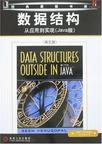数据结构
出版时间:2008-1 出版社:机械工业 作者:SeshVenugopal 页数:491
Tag标签:无
内容概要
本书用一种更加容易理解的“从外向里”的方式讲授数据结构,首先通过接口和行为来理解对象,然后再介绍其实现细节。也就是说,首先讲述如何把数据结构应用于解决问题,随后引出数据结构的实现方法(也就是如何构建数据结构),简单来说,就是在讲述如何构建一个对象之前先研究它做什么。这种讲述方式有非常明显的优势:首先,有利于读者更快地把他们所学的知识运用于实际的应用开发中;其次,帮助读者理解并运用封装、接口与实现的分离以及代码复用等重要的面向对象设计原则。 本书采用“从外向里”(从价格标签接口到实现)的方式,给出独特的学习数据结构的途径: 1)通过讲述数据结构的性质及其实际应用来引入一个数据结构。 2)通过给出实现数据结构的Java类的公有接口来形式化这个数据结构的特征性质。 3)通过使用在第2步中所给出的Java类的接口编写。Java应用程序来进一步说明数据结构的用途。 4)设计并实现数据结构,即开发在第2步中所给出接口的Java类的代码,分析操作的运行时间并对照价格标签(价格标签是指接口操作的运行时间)验证这些运行时间。
作者简介
Sesh Venugopal拥有拉特格大学博士学位,现为拉特格大学计算机科学系教授和本科生指导主管。他还经营自己的IT和教育咨询公司。
书籍目录
PrefaceList of Class Files1 Object-Oriented Programming in Java 1.1 Objects and Encapsulation 1.1.1 Objects 1.1.2 Lifetime, State, and Messages 1.1.3 Clients of an Object 1.1.4 Separation of Interface from Implementation 1.2 Classes 1.2.1 State and Behavior 1.2.2 Method Overloading 1.2.3 Object Creation, Constructors, Garbage Collection 1.2.4 Method Invocation 1.2.5 Static Fields and Methods 1.2.6 Object References 1.3 Inheritance 1.3.1 Superclass and Subclass 1.3.2 Inherited and Specialized Fields 1.3.3 Constructors 1.3.4 Object Creation 1.3.5 Inherited and Specialized Methods 1.3.6 Method Overriding 1.4 The Object Class 1.4.1 The equals Method 1.4.2 The toString Method 1.4.3 The clone Method 1.5 Exceptions 1.5.1 Interpreting an Exception Message 1.5.2 Homegrown Error Handling 1.5.3 Throwing an Exception 1.5.4 Catching an Exception 1.5.5 Exception Class 1.6 Input and Output 1.6.1 Terminal-Driven IO 1.6.2 File-Based IO 1.6.3 String Tokenizing 1.6.4 Writing an Exception Class 1.7 Class Packages 1.7.1 Java Packages 1.7.2 Organizing Packages 1.7.3 Name Conflict Resolution 1.8 Access Control 1.8.1 Private Access 1.8.2 Package Access 1.8.3 Protected Access 1.8.4 Public Access 1.8.5 An Example 1.9 Polymorphism 1.9.1 Polymorphic Reference 1.9.2 Casting up the Class Hierarchy 1.9.3 Casting Down the Class Hierarchy 1.9.4 The instanceof Operator 1.10 Abstract Classes 1.10.1 Abstract Class Shape 1.10.2 Abstract Class Properties 1.11 A Game Park Example 1.12 Interfaces : 1.12.1 The Java interface Construct 1.12.2 Implementing an Interface 1.12.3 Interface as a Type 1.12.4 The Need for Interfaces 1.12.5 Extending Interfaces 1.13 Generics 1.13.1 Using java. uti 1 .ArrayLi st for Collections 1.13.2 The java. uti I. Ar rayLi st Public Interface 1.13.3 Implementing a Generic Class 1.13.4 Implementing a Generic Interface 1.13.5 Static Template Methods 1.14 Summary 1.15 Exercises 1.16 Programming Problems2 The Big Picture 2.1 What Are Data Structures? 2.2 What Data Structures Do We Study? 2.3 What Are Abstract Data Types? 2.4 Why OOP and Java for Data Structures? 2.5 How Do I choose the Right Data Structures?3 Efficiency of Algorithms 3.1 Polynomial Arithmetic: A Running Example 3.2 Basic Operations 3.3 Input Size 3.4 Asymptotic Growth of Functions 3.5 Order and Big Oh……4 Unordered List5 Ordered List6 Queue7 Stack8 Recursion9 Binary Tree and General Tree10 Binary Search Tree and AVL Tree11 Heap12 Hash Table13 Sorting14 Graphs I:Algorithms15 Graphys II: ImplementationIndex
编辑推荐
《经典原版书库·数据结构从应用到实现(Java版)(英文版)》概念清楚,逻辑性强,内容新颖,可作为高等院校计算机软件专业与计算机应用专业学生的双语教材和参考用书,也可供计算机工程技术人员参考。
图书封面
图书标签Tags
无
评论、评分、阅读与下载
用户评论 (总计1条)
- 本书为最新出版的英文原版书籍,内容较新,书中词汇还算容易懂,没有用什么BIGWORD,是一个标准和教材,我只是用来平时翻看一下,对比一下而已,学习的时候还是用中文的(个人英文水平有限)。
